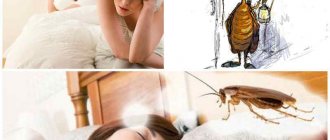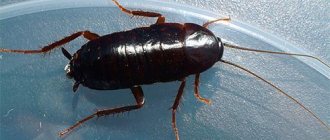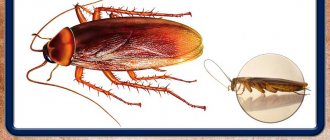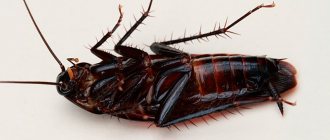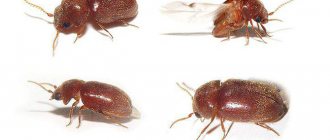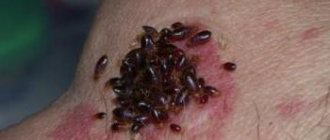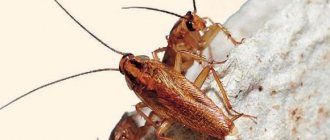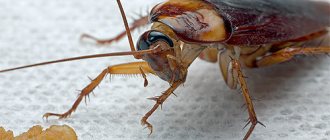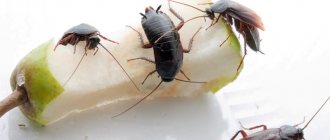Not only owners of private houses and farmsteads, but also residents of comfortable apartments face the problem of insects. A frequent guest of apartment buildings is the Russian cockroach or the red cockroach, familiar to almost everyone.
However, we cannot exclude the appearance of even more unpleasant visitors, namely black or oriental cockroaches.
These insects are large in size, their body length can be three centimeters or more, they have a specific unpleasant odor, and can cause damage to both the home and its owners.
Black sewer cockroaches can damage electrical wiring and other communications, in addition, they are carriers of infectious diseases dangerous to humans. How to get rid of uninvited guests at home, how to poison black cockroaches and how to prevent their reappearance? Let's talk about this in more detail.
What do sewer cockroaches look like and how to deal with them?
Insects, including cockroaches, tend to be a problem in many older buildings. Although it is unusual, it is not uncommon to see cockroaches coming out of gutters, especially in older buildings. It is known that, at the moment when targeted baiting of insects begins in some place, detecting pesticides, cockroaches try to escape from the poisoning zone in any possible way, including from drains.
Cockroaches can hold their breath for 40 minutes. This allows them to move from house to house through sewer systems. By the way, before you flush cockroaches down the toilet, remember this fact. Flushing a cockroach will not kill it.
These insects quickly develop immunity to many of the insecticides that have been used to kill them for years. Cockroaches are apparently smart enough to detect pesticides and find ways to avoid them. The sewers are a great way to escape and migrate to new safe areas.
From the point of view of cockroaches, the sewer is an ideal home. They thrive in the damp darkness, feeding on decaying organic matter and countless refuse. The underground sewer system is a real resort for them: warm in winter and cool in summer. Sewers provide protection from people and predators (with the possible exception of hungry rats). There is plenty of water here, and their lunch takes place in a 24-hour restaurant with a self-assembled tablecloth of delicious human waste.
Appearance
A large insect that grows up to 29 mm: the length of an adult female is 20–27 mm, the male is 18–29 mm. Sexual dimorphism is well expressed. General color: black or dark brown. The chitinous cover is shiny. The female has a wider body than the male. But the real difference between male and female black sewer cockroaches is their wings. This sign allows you to determine at first glance what gender the insect is. The male has long wings, covering ⅔ of the abdomen. The color of the wings is dark brown.
The female is short-winged. In the photo of sewer cockroaches, she looks like a nymph. The wings are completely invisible. “Alive” you will also have to look closely to find its wings. If the photo shows a cockroach with well-developed wings and an ootheca at the end of the abdomen, this is a different species, of which there are more than 4,000 species in the cockroach order. And it is unlikely that this long-winged female will ever be encountered in real life.
Black beetle
Interesting!
Both sexes of black cockroaches cannot fly. The female eastern cockroach is very similar to the Florida woodland cockroach, but the latter is distinguished by a brighter red-brown color.
Why are black cockroaches dangerous?
Among the reasons why black cockroaches are considered dangerous is their feeding habits.
Cockroaches eat dead skin, dead animal meat, and spoiled food. Because they defecate inside homes and even food service establishments, they can transmit any kind of infection. Cockroaches can even leave their feces directly on food, which you can then eat. If food is contaminated with cockroaches and is subsequently consumed by a person, food poisoning can occur. Symptoms that this has happened to you include abdominal pain, nausea and vomiting.
Cockroaches can also transmit other diseases through their droppings. Serious diseases associated with cockroaches from cross-infection include typhoid fever, dysentery, leprosy and cholera.
Staphylococcal and streptococcal infections
There are many types of bacteria that cockroaches carry. While most bacteria are harmless, there are some that can lead to serious infections. For example, Staphylococcus aureus can cause boils in people, as well as serious infections of the lungs and heart. Streptococcal infections can also result from direct or indirect contact with cockroaches.
Allergies and asthma
Of all the pests that live indoors, cockroaches are the most dangerous for allergy sufferers. Trouble can come from allergens found not only in the saliva of cockroaches, but also in their shed skins and feces. Signs of an allergy include itchy, watery and irritated eyes and frequent sneezing. A rash may appear on your skin if you are allergic to cockroaches.
Asthma attacks are more common in families living in areas infested with cockroaches. During an asthma attack, a person begins to cough, feel tightness in the throat and chest, and has difficulty breathing. The severity of symptoms will vary from person to person, and in some cases, asthma attacks can be life-threatening.
Research shows that cockroaches are a leading cause of asthma and allergies! In some cities, up to 45% of children are allergic to cockroaches. Many children develop asthma due to exposure to cockroaches.
What to remember
- Keep your home tidy and dry.
- Seal the cracks, change the seals, and install mesh on the ventilation ducts.
- In the store, read the instructions for different insecticides and decide which form suits you best - gel, powder, spray, tablet.
- If you don’t want to use chemical industry products, then try folk remedies. But they may not be effective enough.
- If you like a peaceful option, use an ultrasonic repeller.
- If pests walk around your premises without any remorse, and your neighbors have the same picture, contact a professional disinfection service for removal services.
See you in the next article!
Where do black cockroaches come from?
Although cockroaches love to take up residence in various types of buildings, both new and old, many often begin their lives outdoors. When it gets too cold or too hot outside, they start looking for a new home. Instead of directly invading your apartment, they often end up in the drain first, which is usually warm and dark. Sewers provide the food and water insects need to survive and also provide protection from the elements.
Cockroaches are explorers and soon begin crawling up dry drainpipes, laying eggs along the way. As the larvae hatch, they continue to crawl up and out of drains, often ending up in dark closets, trash rooms, basements, etc.
Finding cockroaches in the basement or coming out of the sewer usually indicates:
- They found ways to invade the building from the outside.
- They are hungry and looking for food.
- If you see one cockroach, there are many others that will soon be crawling onto your territory.
- You should expect sewer odors to follow the arrival of cockroaches.
The presence of cockroaches in the sewer system would not be a problem if they remained in place. But they don't. Adult nymphs tend to migrate in search of food and new places where they can raise a new population. They can simply leave the sewer, pushing out ventilation dampers, and enter buildings.
Sewer roaches can also enter buildings when the main sewer line is backed up, dumping thousands of roaches. Heavy rains can push cockroaches out of combined sewers and into basements. Or the drain trap may dry out and the roaches may simply walk through the drain pipes, through the trap, and out of the floor drain.
When cockroaches occupy sewer systems and, more importantly, emerge from them, solving the problem is not as easy as you think. The older the sewer system, the more likely it will be infested with cockroaches and rats, and the more difficult the problem will be to solve.
Drain under the sink
Plum trees provide a good, cool, quiet place to breed, eat food, and hide for protection.
Prevent sewer roaches from getting into your kitchen and bathrooms by making sure sinks are used regularly.
The pipes below the drain have a U-shaped loop called a “trap.” If the bathroom is not used, all the water in the "trap" dries up and sewer roaches enter your home.
When drains are used regularly, water remains at the bottom of the U-shaped pipe, preventing the water from draining completely. This “trapped” water blocks sewer roaches from coming through the drain and into your home.
If you are not a professional plumber, you will have to study the design of your home sewer system from photos. This is essential if you have a problem with sewer invaders.
Harm to humans
As stated above, cockroaches transmit diseases because they carry pathogenic microorganisms in their bodies that can be transmitted to us, and cause diseases such as suffocation, tuberculosis, cholera, leprosy, dysentery, typhoid fever and more than 40 other pathogenic bacteria and viruses.
Lifestyle and habitat
Black beetles are nocturnal. They leave their nests in the middle of the night in search of food. Favorite places in the house are hidden.
This:
- A pantry where food supplies are stored.
- Bathrooms.
- Basements, cellars.
- Garbage boxes.
- Cracks, cracks in walls, floors, furniture.
- Warehouses and other places where there is food and few people.
Black cockroaches are also found in nature, especially near landfills and other similar places where man himself has created unsanitary conditions.
They live in colonies, so if at least one parasite has caught your attention, you can be sure that there are already several dozen of them living in your apartment.
On a note! Black cockroaches are unique insects: they can go without food for up to 12-14 days. It is important to note that insects can survive without air for up to 40 minutes.
If you happen to see a cockroach in the toilet, you should not think that the problem can be solved by simply rinsing it - the insect will not die at all, but will most likely return or crawl out somewhere else, but it will remain alive and healthy.
How to block cockroaches from entering your home
Cockroaches often live in bathrooms and kitchens where they have a good source of water and food.
If you find cockroaches in your drains, follow these steps:
- Seal your drain pipes. Use a flashlight to find any cracks or holes in your drain pipes. If you find any cracks or holes, seal them with an appropriate sealant.
- Repair leaking faucets. Standing water attracts cockroaches.
- Seal cracks and holes around drain pipes. You can use duct tape to quickly repair cracks and cracks. For a more permanent solution, use silicone caulk, plaster or cement.
- Look for gaps around the pipes under the sink. Fill these gaps with silicone caulk or polyurethane foam. You can fill large holes with steel wool or copper mesh before sealing them.
- Fix holes in your walls. Use expanding foam insulation to seal any spaces around pipes where they pass through walls.
- Stop condensation. Wrap insulation tape around any pipes that produce condensation. When you remove the water source, the cockroaches will go elsewhere to get water.
Cockroaches can enter premises in other ways. They can enter from open areas, especially garbage containers and related businesses that have poor sanitation; they can be introduced into the home unknowingly through packaging and containers.
How to Help Prevent Cockroaches from Getting into Your Drains
- Move or remove trash cans. Garbage cans under the sink or bathtub can attract cockroaches.
- Cover drains with a stopper at night. You can use rubber drain caps or metal drain screens. Cockroaches are nocturnal, so it is important to block their migrations at night.
- Clean kitchen drain. Pour cleaner into the kitchen sink to remove food particles that attract cockroaches.
- Keep meters and appliances clean. Avoid leaving food on counters or in the kitchen sink, especially overnight.
What happens if the problem is ignored
- Cockroaches eat any organic food they can find. At best, it will be garbage in a bin, at worst, food left on the table, which will then be hopelessly spoiled.
- Cockroaches are carriers of many dangerous diseases, ranging from helminthiasis to dysentery.
- Black cockroaches, being quite large in size (up to 5 cm in length), can disable household appliances and damage electrical wiring. In addition, adults emit an unpleasant odor.
Home protection against insects
Realizing that insecticides no longer deter many cockroaches and other insects, it is safest to call a pest control company as a first step. A pest control professional can help determine the type of cockroach infestation, check how cockroaches are getting into a building, and suggest ways to eliminate them.
Non-chemical methods of cockroach control
Like most pests, sewer cockroaches need three things: food, water and shelter. If you can eliminate just one of these things through proper sanitation, the cockroach population will be forced to die or move elsewhere.
- Avoid old boxes and stacks of papers where cockroaches can hide.
- Use a garbage can or bin with a tight-fitting lid and store trash in a sealed plastic bag overnight.
- Eliminate leaky drains and taps; Cockroaches can only live on water.
- Clean kitchen appliances thoroughly
- Wash pet bowls overnight or place them in a plastic bag.
- Vacuum regularly and limit food consumption to one room of the house. This will help prevent the pests from spreading to other areas such as bedrooms.
- Seal and repair holes around doors, windows, plumbing pipes and baseboards.
- Place mesh screens over windows, floor drains and vents.
Insect repellent gel
We recommend applying gels to all visible cracks and crevices, including under, behind and next to appliances, behind outlets, along pipe clamps, inside wall voids and on top of kitchen cabinets near the ceiling.
Continue to apply the gel every 4-6 weeks for up to 6 months, or until all signs of infection have resolved.
Powders
Using a hand rag and following label directions, apply the powder to areas where cockroaches hang out—under and behind baseboards, behind wall outlets, in wall voids, in cabinets and cupboards, and under appliances such as washers and dryers.
Aerosols
Contact sprays kill cockroaches immediately on contact and can also be used to flush cockroaches out of suspected hiding places. Most aerosols contain a chemical used to destroy and impede the life cycle of insects in their egg and larval stages. The idea is that if an insect cannot reach maturity, it cannot reproduce. Any form of “birth control” for cockroaches and other pests helps keep populations under control, preventing current and future infestations.
Insect traps
Traps are actually effective for cockroaches, but if you need to spray other pests, be sure to keep baits and sprays in separate areas so they don't interfere with each other.
Insecticides
Insecticides do not drive away, but destroy cockroaches. Their serious disadvantage is that you will have to constantly remove the destroyed insects. Another disadvantage is the danger they pose to people and pets. Thus, the use of certain types of drugs is strictly prohibited if there are small children and pets in the house.
If the situation is critical, transport children and animals and carry out treatment using a double dose of drugs. Close all windows and doors, leave your home for 4-6 hours. When you return, thoroughly ventilate the room, sweep away dead insects and wet clean all sprayed or lubricated surfaces.
Insecticides are available in the form of sprays, dusts, crayons, gels and traps. All of these products have different trade names, but they work approximately the same. Under the influence of their active substances, the cockroach becomes paralyzed and soon dies. Please read the attached instructions carefully. Use medications as often as needed. Typically re-use is required one month after the first application. Continue application until the insects are completely gone.
Keep in mind that sometimes even chemicals do not guarantee a complete solution to your problem. If a cockroach drinks even a drop of water, the insecticide will not work. Therefore, in order to get rid of pests, be patient and combine the use of several methods. Practice shows that it will take about 2 months to kill insects.
Mechanical methods
As previously written, "P", "J" or "U" style traps are found under almost all sinks, including floor drains. The purpose of these traps is to retain water, which helps prevent sewer odors from entering the building and blocks cockroaches from getting into sewer drains and sink drains. Maintaining sewer drains is an important task. The first step is to conduct a drain audit. Know the location of all drains in your home. Pay special attention to restroom floor drains.
Additionally, prevent cockroaches from moving through sewer pipes and dry floor drains by ensuring the floor is drained every week.
You can make sure your drain pipes don't dry out using the following steps:
- Water: Pour a quart of cleaning solutions, bleach or other chemicals into all floor drains and less-used drains at least once a month. In hot, dry climates, you may need to do this weekly.
- Prepare mineral oil. Apply a thin layer of vegetable oil or mineral oil down the drain to keep the water from evaporating for several weeks, possibly months. Repeat this every six weeks or every two months.
- Drain trap control. You can install a controller on each water source. When the water evaporates, it releases a small amount of water down the drain to refill the drain.
These methods will not only keep drains and catch basins filled with water to help prevent cockroach incursions, but can also prevent sewer odors from entering restrooms and other areas of the facility. The release of sewer odors can be more than unpleasant, it can be dangerous if the odors contain toxic gases. Taking steps to maintain drains is another way you can stay healthy.
Using traps
In cases where cockroaches do not want to leave the premises, you can try to deceive them using traps. You can use different foods to attract their attention. You can be sure that not a single cockroach will refuse food lying in a visible place.
Grease the inner walls of a glass bowl with sunflower oil. Insects will easily get inside, attracted by the aroma of the treat, but will not be able to get out. Such traps should be emptied once every 2 days.
Another popular trap involves the use of glue. Spread it around the edible bait. It will stop the cockroaches on their way to food - their paws will stick firmly to the floor.
An example of a trap.
To increase efficiency, you can poison the bait. Mix a few whispers of boric acid into it. You can hard boil several eggs and mix the mashed yolk with acid. Roll the resulting mass into small balls. Scatter them around the bathroom, kitchen and other places where insects gather.
Modern ready-made traps are even more original. Some of them kill insects with an electric discharge, while others affect the cockroach's reproductive system, making it infertile.
Prevention
If you find sewer cockroaches, you need to take preventive measures to prevent food contamination, but this is not possible if the insects move freely around food storage areas. It is well known that biofilm that accumulates in drains contains harmful bacteria. Cockroaches that come from drains onto food contact surfaces can transmit these pathogens wherever they take up residence.
You need to do a thorough inspection, not just a step-by-step inspection, and then choose solutions to solve the problem and treat the insect infestation. Whether cockroaches come indoors through drains or collect in drains after they enter through other means, there are a number of solutions that can be used to eliminate cockroaches and make drains less attractive.
Such solutions include:
- External procedures. Active perimeter pest control is required, including habitat reduction along the outer perimeter, a barrier spray on the foundation and around entry points, and a line of moisture-resistant granular bait applied beyond the spray barrier. Always read the label to determine which products can be used and where.
- Drain cleaning. Cleaning drains by hand can be helpful, but be aware that scrubbing, steaming, and pressure washing can atomize pathogenic bacteria and potentially transfer them to food surfaces or processing.
Bio-sanitation products can effectively treat wastewater in environments with chronic moisture and high organic loads, and can also keep wastewater clean by digesting organic buildup that can harbor both pests and pathogens.
Keeping drains clean and using cleaning products can also provide further pest control. Regular use of any cleaning product is very important, as even those that do not kill insects will eliminate conditions conducive to insect breeding.
- Drain procedures. Some pesticides can be used in and around drains, but some are strictly prohibited, so read labels before use. If there is any movement in the drain, especially if water is running, be careful with chemical use; make sure you are not contaminating groundwater or areas where water flows (such as into an open stream).
- Drain traps. Traps in drain lines must be installed and operating properly to prevent cockroaches from entering drains and into the building through sewer or outdoor wastewater treatment plants. The sealing valve to catch water should allow water to flow out, but not allow insects to enter the room. Traps can also eliminate gases and odors that can come through drains and attract insects.
- Internal inspections. Regular and thorough inspections of areas adjacent to drains will indicate whether the drainage program is effective. Cockroaches can hide in hard-to-reach places under and behind equipment, in stainless steel table legs, behind and under cracked tiles, and in wall voids that are accessible through plumbing and utility passages. Inspect these areas for cockroaches. If necessary, implement a site-wide bullying program as permitted by regulations.
Professional fighting methods
When sewer cockroaches appear, it is better to seek help from SES specialists who use the cold and hot fog method for disinsection. Treating a room at the initial stages is most effective and allows you to quickly get rid of insects. Let's look at two key methods of professional pest control.
Cold fog
Cold fog is a common method of disinfestation of residential premises. This is a fine spray of insecticide using a special device - a generator. The equipment ejects the working solution from the nozzle at high speed in the form of tiny particles that resemble steam. They hover in the air and settle on all surfaces, penetrating into cracks and hard-to-reach areas.
Cold fog does not damage decorative finishes, furniture and other interior items. This method ensures high-quality processing of an object of complex configuration in just a few hours.
